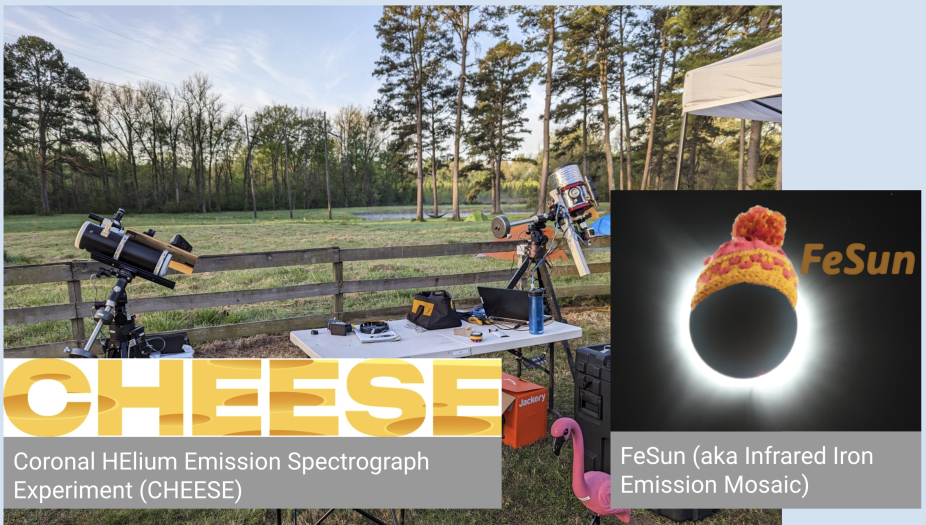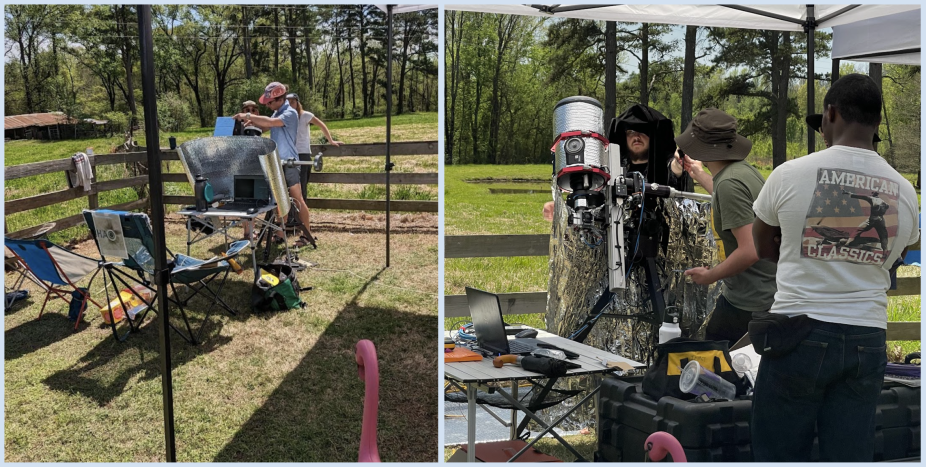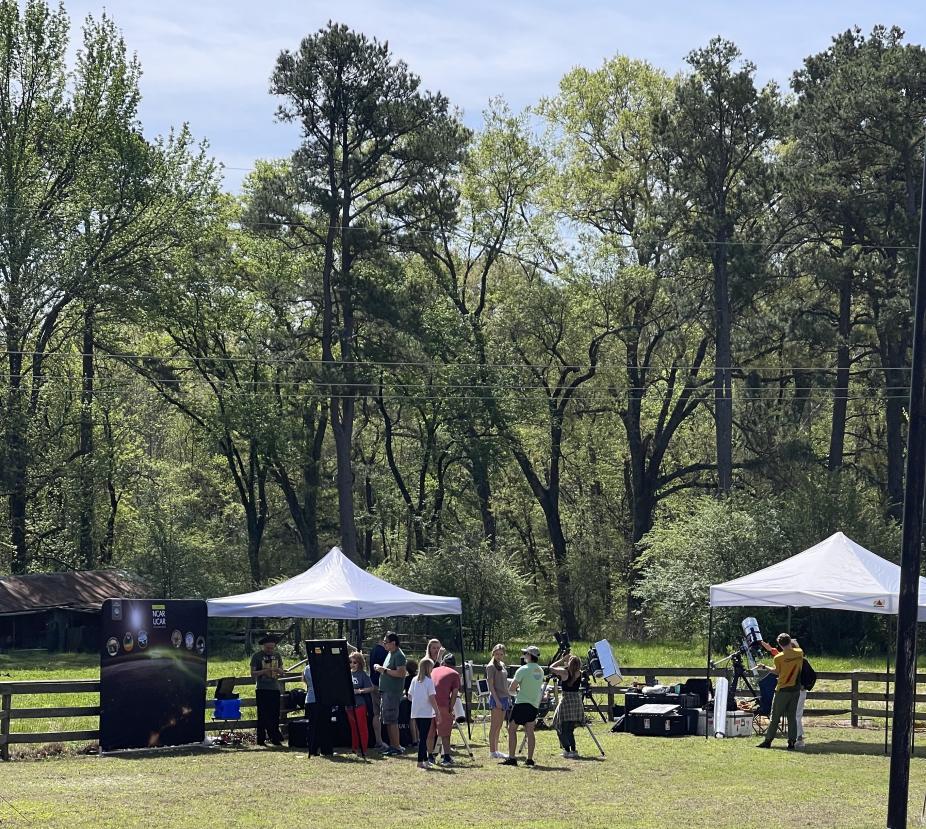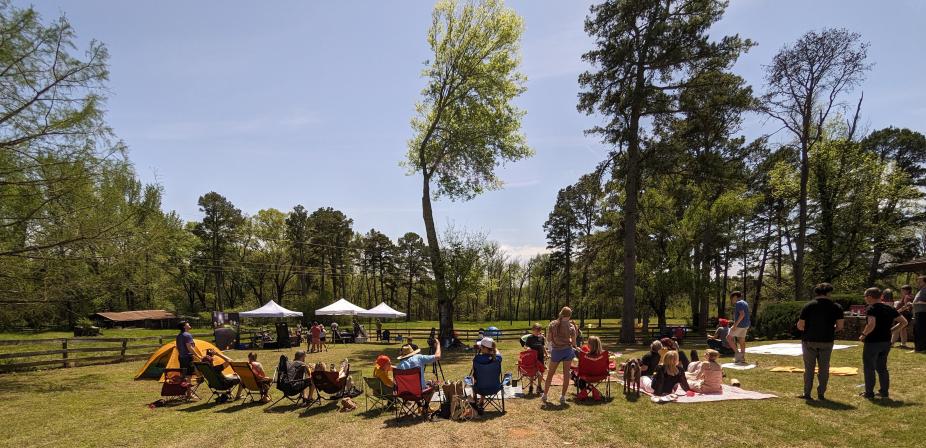
Composite image of the eclipse as seen from Dardanelle, AR. A narrow H-alpha filter was used to capture the emission of the solar disk during the partial phases of the eclipse, while the totality phase was captured in white light emission.
The total solar eclipse on April 8, 2024, was a great opportunity for the team of HAO, NSO, and NOAA scientists and collaborators to travel to a location on the totality path with the goal of running unique science experiments. Using additional telescopes, binoculars, and outreach materials, we were able to capture the eclipse throughout its phases and share our passion with a very excited local crowd.
Two eclipse science experimental setups were designed and built by our team at the HAO facility and tuned to observe the infrared solar corona during the totality phase of the eclipse: the Coronal HElium Emission Spectrograph Experiment (CHEESE) led by HAO’s Momchil Molnar and FeSun (read Iron Sun) led by NSO's Alin Paraschiv. CHEESE is a high-resolution spectrograph and FeSun is a coronagraphic filter imager designed to build a mosaic of the corona. We hope to reveal new and exciting science using emission lines of Iron and Helium that form in the infrared range of the light spectrum.

The two eclipse experiments are assembled and waiting for final adjustments.
The eclipse team consisted of Momchil Molnar, Alin Paraschiv (NSO), Maurice Wilson, David Afonso Delgado, Gabriel Dima (NOAA), Daniela Lacatus, Paul Bryans, and Kalista Tyson (student). The whole expedition was a huge adventure for our team, and after some rollercoaster moments, we successfully achieved perfect weather conditions through the entire eclipse; considering what we went through, this was no small feat! (Now that the expedition is over we begin the long task of analyzing and interpreting our infrared science data to uncover new coronal insights.)
Fredericksburg, TX, was our initial and carefully chosen location. Unfortunately, after a 10-hour drive there, we understood our eclipse viewing chances were extremely slim due to overcast skies. Suddenly we were scrambling to find a better location; we decided to drive northeast another 10 hours to Dardanelle, AR. The extra day of driving was a hardship and we missed a night of testing. Sadly, we left Paul behind because he was meeting his family in Texas. Happily, our change of location to Arkansas was a great success as the weather was lovely, with clear skies throughout the eclipse!
On Sunday morning, before the Monday eclipse, Alin and Momo (experiment leads) finally started assembling the experiments. In utter horror they realized that we were missing one of four boxes containing the crucial mount heads for both experiments. This became a joke of how many PhDs does it take to account for four boxes and load those boxes into cars.
Luckily, Kalista Tyson (former REU student and HAO visitor), came to our rescue with a special delivery, arriving at our location in Arkansas on Monday at 4am, with the "invisible at departure box." With sleep deprived eyes, we rushed to assemble the experiments and do as much of the alignment and testing in a few hours, instead of the planned preparation time of two days and two nights. In addition, we had to address some issues that were not completely ironed out, especially given the change in location. Despite it all, the experiments executed their observation sequences, and data was acquired.

The experiments PIs doing final adjustments to the instruments as the eclipse approaches the totality phase. (P.S. ‘Bene Gesserit’ infiltrators were on site if you look carefully!)
We also had a telescope dedicated to capturing the solar disk in H-alpha emission throughout the eclipse phases. The composite image above illustrates the capture results beautifully. An additional telescope plus two pairs of binoculars were available to provide the public with a closer view of the eclipse progression and enabled them to photograph the solar disk being gradually obscured.

In addition to the science experiments, we also had a telescope and binoculars available for the public, as well as a booth where we shared cool science tidbits and answered questions.
At the outreach booth we provided materials on eclipses, the sun, its structure and phenomena, plus its influence on the solar system. We also introduced the pinhole concept for safe eclipse viewing. The public was excited to have “real scientists doing science” in a backyard, small-town setting where they were comfortable interacting and asking questions. We were energized by their science queries and curiosities about the broader impact of our work and science in general.

Moments before totality, everyone was getting ready to enjoy the astronomical show and/or watch the excitable scientists acquire their data.
Once the eclipse ended, we rushed to pack up everything because a storm front was arriving with intense rain and winds. While some of us began driving back that evening, other team members stayed another night. Due to heavy rains, they became stuck in the mud and had to be pulled out by a tractor the following morning. The first group arrived back to Boulder on Tuesday near midnight, while the campervan group arrived after 4am on Wednesday morning.
The enormous effort that went into preparing the experiments and the actual expedition was definitely worth it. We learned a lot by building and deploying the experiments in the eclipse path, and in spite of some setbacks, both experiments ran successfully and data was acquired! In addition, we got to experience a unique astronomical event, share our passion for science and solar physics in particular, and hopefully make a lasting impression on our public audience.
We want to emphasize once again our immense gratitude to Kalista for dropping everything without a second thought and driving to our rescue! Without her swift intervention, all the effort invested in preparing the experiments would have been futile!
Furthermore, we are grateful to Skylar Shaver and the Ring family for graciously hosting us on their property in Dardanelle, Arkansas, on very short notice. Because of their generosity and in spite of the impromptu change in location, we were able to set up our experiments and our outreach booth. Best of all, we ended the day sharing the total eclipse experience with ~80 people and 8 dogs.
We want to thank everyone who made this expedition possible: members, mentors, institutions, friends and family! We are grateful to Paul Bryans and Sheryl Shapiro for their work on coordinating the logistics and making sure this adventure could happen (plus Paul’s sacrifice during the trip). We are also grateful to Roberto Casini, Matthias Rempel, Ben Berkey, Alfred de Wijn, Phil Judge, Kevin Reardon (NSO), and Tom Schad (NSO) for their guidance, support and insights on how to run eclipse experiments, things to consider, and for giving us a hand when we inadvertently got stuck. And last but not least, we want to thank Holly Gilbert for ensuring this effort had adequate resources, without which nothing would have been possible.
Story by Daniela Lacatus, edited by Wendy Hawkins